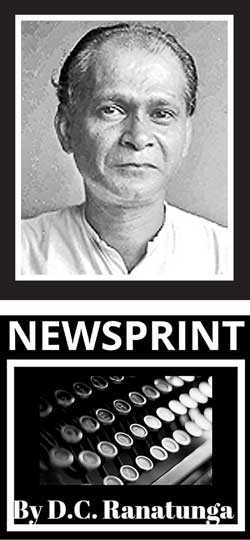Tuesday Jul 01, 2025
Tuesday Jul 01, 2025
Saturday, 6 April 2019 00:05 - - {{hitsCtrl.values.hits}}

 Dahanayake’s short stint as prime minister turned out to be exciting and eventful, proving ‘good copy,’ as we say in journalist jargon.
Dahanayake’s short stint as prime minister turned out to be exciting and eventful, proving ‘good copy,’ as we say in journalist jargon.
He continued with the same Cabinet ministers in the first few weeks when most ministers began to indicate their displeasure on the way he was directing the government. The key issue was the slow progress made in identifying the culprits responsible for the assassination of Prime Minister Bandaranaike and taking them into custody.
It was a busy time for the media. Dahanayake’s strategy, his relationship with the ministers, reaction of opposition parties, progress in the assassination case – readers waited for the news of all these. Dahanayake had his way with the State-owned radio.
Things began to happen within six to seven weeks of Dahanayake’s premiership. Minister Vimala Wijewardena’s close friendship with Mapitigama Buddharakkitha Thera who was second accused of the Bandaranaike assassination case resigned on 21 November 1959 following her arrest. (She was released when the police found that she had no hand in the assassination.) Minister Stanley de Zoysa resigned the following day when his brother was taken in.
Happenings in Parliament were equally exciting with the Government having to face two votes of no confidence – one against the Prime Minister and the other against the Justice Minister – both in relation to the delays in bringing to book those responsible for the assassination. The Government narrowly escaped with a majority of one vote. As things were getting hotter, Dahanayake, without discussing with the Cabinet, decided to call for a general election and advised the Governor-General to dissolve Parliament. Sir Oliver issued the gazette notification on 5 December 1959, dissolving Parliament and fixing the election to be held on 19 March 1960. The date to hand over nominations was 4 January.
Dahanayake was now more of less ‘all powerful’ as head of the caretaker government and possibly to show his authority he resigned from the SLFP. The party’s Executive Committee refused to accept his resignation and instead sacked him.
Now it was ‘open warfare’ between the Prime Minister and the ministers. Retaliation came in the form of sacking five Ministers – MPs T.B. Ilangaratne, Maitripala Senanayke, P.B.G. Kalugalle, M.P. de Zoysa and Senator A.P. Jayasuriya. With the media having a hunch that drastic things would happen, we had to keep vigil throughout the night. The letters discontinuing the ministers were issued at midnight.
Minister C.P. de Siva, who had by then returned from London, resigned in protest of the sacking of ministers.
Dahanayake handpicked whom he thought would be faithful to him as ministers. He created a new ministry – Ministry of Internal Security – and Sydney de Zoysa, senior police officer, was appointed Permanent Secretary.
He sacked another set of ministers and formed a new party calling it the ‘Prajatantravadi Pakshaya’. He then started to get ready for the March election. Applications were called from persons who wanted to join his party and contest.
When he started campaigning he used to come up and pick up the journalists who were covering the election meetings. I can remember him coming to Lake House in the official car to pick up Joe Sigera, senior Daily News reporter who covered his tenure as PM.
Discover Kapruka, the leading online shopping platform in Sri Lanka, where you can conveniently send Gifts and Flowers to your loved ones for any event including Valentine ’s Day. Explore a wide range of popular Shopping Categories on Kapruka, including Toys, Groceries, Electronics, Birthday Cakes, Fruits, Chocolates, Flower Bouquets, Clothing, Watches, Lingerie, Gift Sets and Jewellery. Also if you’re interested in selling with Kapruka, Partner Central by Kapruka is the best solution to start with. Moreover, through Kapruka Global Shop, you can also enjoy the convenience of purchasing products from renowned platforms like Amazon and eBay and have them delivered to Sri Lanka.
Discover Kapruka, the leading online shopping platform in Sri Lanka, where you can conveniently send Gifts and Flowers to your loved ones for any event including Valentine ’s Day. Explore a wide range of popular Shopping Categories on Kapruka, including Toys, Groceries, Electronics, Birthday Cakes, Fruits, Chocolates, Flower Bouquets, Clothing, Watches, Lingerie, Gift Sets and Jewellery. Also if you’re interested in selling with Kapruka, Partner Central by Kapruka is the best solution to start with. Moreover, through Kapruka Global Shop, you can also enjoy the convenience of purchasing products from renowned platforms like Amazon and eBay and have them delivered to Sri Lanka.